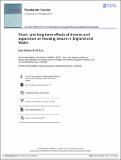Files in this item
Short- and long-term effects of divorce and separation on housing tenure in England and Wales
Item metadata
| dc.contributor.author | Mikolai, Julia | |
| dc.contributor.author | Kulu, Hill | |
| dc.date.accessioned | 2017-11-29T13:30:06Z | |
| dc.date.available | 2017-11-29T13:30:06Z | |
| dc.date.issued | 2017-11-28 | |
| dc.identifier | 250163911 | |
| dc.identifier | f6a92de7-455b-4ff3-adce-0885a3510b52 | |
| dc.identifier | 85035086195 | |
| dc.identifier | 000425792600002 | |
| dc.identifier.citation | Mikolai , J & Kulu , H 2017 , ' Short- and long-term effects of divorce and separation on housing tenure in England and Wales ' , Population Studies , vol. 72 , no. 1 , pp. 17-39 . https://doi.org/10.1080/00324728.2017.1391955 | en |
| dc.identifier.issn | 0032-4728 | |
| dc.identifier.other | ORCID: /0000-0002-7733-6659/work/48516896 | |
| dc.identifier.other | ORCID: /0000-0001-8808-0719/work/75996991 | |
| dc.identifier.uri | https://hdl.handle.net/10023/12189 | |
| dc.description | PartnerLife is supported by a grant from the Netherlands Organisation for Scientific Research (NWO, grant no. 464-13-148), the Deutsche Forschungsgemeinschaft (DFG, grant no. WA 1502/6-1) and the Economic and Social Research Council (ESRC, grant no. ES/L01663X/1) in the Open Research Area Plus scheme. | en |
| dc.description.abstract | This paper investigates the effect of divorce and separation on individuals’ housing tenure in England and Wales. We apply competing-risks event history models to data from the British Household Panel Survey and the UKHLS Understanding Society to analyse the risk of a move of single, married, cohabiting, and separated men and women to different tenure types. Separated individuals are more likely to experience a tenure change than those who are single or are in a relationship. They are most likely to move to private renting; however, women are also likely to move to social renting whereas men are likely to move to homeownership. This pattern persists when we account for time since separation and order of moves indicating a potential long-term effect of separation on housing tenure. This long-term effect is especially crucial for separated women who cannot afford homeownership. | |
| dc.format.extent | 23 | |
| dc.format.extent | 1078127 | |
| dc.language.iso | eng | |
| dc.relation.ispartof | Population Studies | en |
| dc.subject | Separation | en |
| dc.subject | Short- and long-term effect | en |
| dc.subject | Housing tenure | en |
| dc.subject | England and Wales | en |
| dc.subject | Multilevel event history analysis | en |
| dc.subject | H Social Sciences (General) | en |
| dc.subject | HM Sociology | en |
| dc.subject | HQ The family. Marriage. Woman | en |
| dc.subject | 3rd-DAS | en |
| dc.subject.lcc | H1 | en |
| dc.subject.lcc | HM | en |
| dc.subject.lcc | HQ | en |
| dc.title | Short- and long-term effects of divorce and separation on housing tenure in England and Wales | en |
| dc.type | Journal article | en |
| dc.contributor.sponsor | Economic & Social Research Council | en |
| dc.contributor.institution | University of St Andrews. School of Geography & Sustainable Development | en |
| dc.identifier.doi | 10.1080/00324728.2017.1391955 | |
| dc.description.status | Peer reviewed | en |
| dc.date.embargoedUntil | 2017-11-28 | |
| dc.identifier.grantnumber | ES/L01663X/2 | en |
This item appears in the following Collection(s)
Items in the St Andrews Research Repository are protected by copyright, with all rights reserved, unless otherwise indicated.

